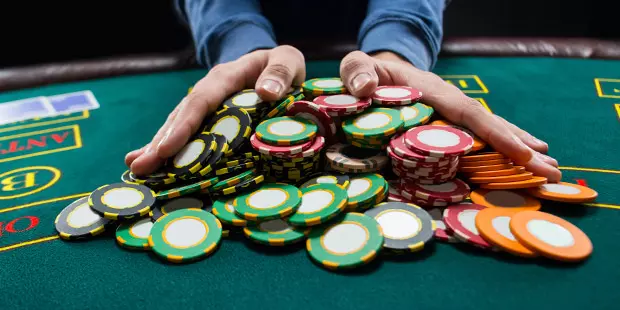All-In. The two most exciting words you can hear in a poker tournament. It means somebody is betting everything he’s got—every single chip—and at that point there are only two things that can happen. One of them is good and one of them is bad.
When You Can Go All-In
You can go All-In at any stage of any No-Limit poker game. You can go All-In playing online poker or playing brick-and-mortar poker. You can go All-In on the Pre-Flop, the Flop, the Turn, or the River. You can go All-In with a big stack of chips, a small stack of chips, or a medium stack of chips.
You can go All-In as the aggressor making a Bet or a Raise, or you can go All-In defensively making a Call. You can go All-In when you have a great hand that is sure to win, and you can go All-In as a big bluff with a nothing hand.
It is possible for two or three or even more players to go All-In on the same hand.
In short, you can go All-In at any time your poker sense tells you it is the right thing to do.
How to Go All-In
Going All-In requires two steps. First you say the words “All-In.” Then you push all your chips into the middle of the poker table.
In poker slang, we say “shove” for going All-In, as in “I shoved” or “he shoved” or “she shoved,” and you can see why: when you go All-In, you literally shove your chips onto the table and it is a tremendous gesture of catharsis and release perfectly captured in that simple phrase “I shoved.”
When you play poker online, the gesture is not so dramatic, as there are no physical chips to actually shove, but the act of going All-In remains equally exciting and suspenseful.
Fair Play and All-In Side Pots
One of the fundamental rules of fair play in poker is that you cannot win more from your fellow player than you risk losing to him. (You can’t expect me to risk losing $200 to you if you risk losing only $100 to me.) Now imagine a poker game among three players with the following chip stacks:
- Player A = 100
- Player B = 300
- Player C = 1000
All three players declare themselves All-In. But how is this going to work? It wouldn’t be fair if Player A could win the entire All-In—$300 from Player B and $1000 from Player C—if he is risking only $100 of his own. And so we solve the problem by creating a Main Pot and a Side Pot.
In this scenario, the Main Pot holds $300:
- $100 from Player A
- $100 from Player B
- $100 from Player C
At the same time, the Side Pot holds $400:
- $200 from Player B
- $200 from Player C
Player C, who started with $1000, still has $700 remaining. This is returned to him and is not at risk.
Now the hand is played and the cards are compared and we have the result:
- If Player A has the best hand, he wins the Main Pot and the player with the second-best hand—either Player B or Player C—wins the Side Pot.
- If Player B has the best hand, he wins both the Main Pot and the Side Pot.
- If Player C has the best hand, he wins both the Main Pot and the Side Pot.
With more players, it is even possible to have multiple Side Pots of different sizes. And if all this sounds impossibly complicated, be of good cheer: when you play poker online, the software will make sure that all winnings and all losses are distributed fairly, equitably, and accurately, every time. If you just understand the Fairness Principle underlying the distribution, that’s all you really need.
Showing All Your Cards
Suppose we are in the Pre-Flop and everybody at the poker table has either folded or gone All-In. Now what happens?
Well, for one thing, there will be no more betting on this hand. And with no more betting, there is no more bluffing, no need to maintain that poker face, no need to hide your hole cards. Both your cards and your emotions can be revealed to the world.
And so, all the hole cards are turned face-up on the table, and the community cards are dealt out: first the Flop, then the Turn, then the River. The atmosphere during this stage of the poker games tends to be simultaneously suspenseful, with anxious anticipation of the cards to be dealt, and relaxed, with everybody upfront and open about their hands. And in the end, of course, all the cards are on the table and the winners and losers are determined.
Losing on the All-In
If you go All-In and you lose the hand, that’s it. It means you are out of chips and out of the poker tournament. Do what you need to do: take a walk, eat a good meal, work out in the gym. Whatever. Everybody has his own way of dealing with disappointment; you surely know yours. And when you’re finished, come back and play some more poker. That’s the best medicine of all!

